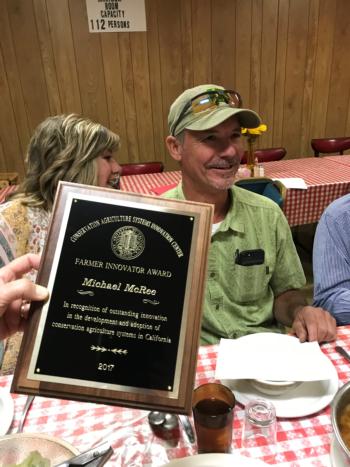CT innovators
Michael McRee - 2017

McRee is a dairy producer milking close to 2000 cows at his farm west of the small San Joaquin Valley town of Chowchilla who also double crops his own dairy forage as well as tomatoes and alfalfa crops on about 850 acres. His pioneering quest to improve the performance of his silage production systems began back in 2007 with tenacity and creativity. Following a great deal of study and experimentation, he developed a very successful strip-tillage system for his silage corps that was spurred initially by his interest in saving passes through his fields to use less fuel and labor. But, after his pioneering efforts with strip-till which were some of the very earliest in the entire San Joaquin Valley, he soon found that the practice held other important benefits for his farm as well. He noticed an increase in the water-holding capacity of his soil since working with strip-tillage, as well as increased consistency in the soil’s ability to absorb water, mellower soil overall, and more consistent crop stands and yields overall. Improved soil tilth, increased soil organic matter, and earthworms, - are all things that now give him consistent yields year to year without extreme highs or lows.
Early on, he was very keen in seeking out information and experience from several other CT pioneers both here in the SJV, as well as during his trips back to the Midwest to learn about management alternatives. When he started out with CT in 2007, he then soon began using his own equipment to do custom work for local neighbors, who have themselves also now adopted CT systems for their own farms. He readily admits that he faced challenges early on. He tried no-till wheat, but was limited in this effort by hard, compacted soils. He began using an Orthman 1tRipR, but found that he needed to go deeper with subsoiling to increase water infiltration. Having the right equipment is a key to the whole endeavor, he points out. He has worked with local NRCS partners and the EQIP program, which assists growers with implementation of practices to improve our soil, water and air resources. He now does fall primary tillage using a Wilcox 7-shank subsoil ripper with a crumbler. Vertical tillage has replaced disc plowing to achieve a smooth seedbed without turning the soil over. Preparation for corn silage planting begins after winter forage is harvested. He explains that he rips down 13-14 inches and uses coulters to prepare the seedbed. After pre-irrigation, he uses the Dawn Pluribus strip till row unit, a tool that preps an eight-inch band of soil for planting. Using GPS, he can run his tractor 6-7 mph for this pass. “With three passes I can do everything,” he says.
Mike McRee has been extremely willing to share his experiences with others and has graciously hosted numerous public field days at his dairy farm over the years.
Additional information about McRee may be found at the CASI Workgroup website at http://ucanr.edu/sites/ct/?story=90&showall=yes
